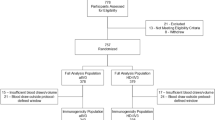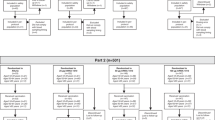Abstract
We aimed to assess the immunogenicity of a single half-dose of AS03-adjuvanted monovalent 2009 pandemic H1N1 vaccine in healthy adults. Healthy subjects age 20–60 years were prospectively enrolled in a cohort receiving intramuscular administration of a single half-dose (1.875 μg of hemagglutinin [HA]) of adjuvanted 2009 pandemic H1N1 influenza vaccine. Data from participants enrolled in a concomitant study of immunogenicity following a full-dose (3.75 μg of HA) are presented concurrently. Sera for assessment of hemagglutination-inhibiting (HAI) antibody to the vaccine strain were obtained before and 14 or 21 days after vaccination. Ninety-seven participants received a half-dose and 50 received a full-dose of vaccine. In the half-dose cohort, Food and Drug Administration criteria for immunogenicity regarding seroprotection and seroconversion rates were met for subjects aged 20–45 years, but not for those aged 46–60 years. There was no statistically significant difference in the proportion of individuals achieving a post-vaccination HAI titre of ≥1:40, the geometric mean titres of post-vaccination antibody, or the proportion of individuals with a four-fold or greater increase in antibody levels between the two cohorts. Participants 46–60 years of age were significantly less likely to be seroprotected at day 21 than those 20–45 years old in both cohorts. Immunogenicity of a half dose of adjuvanted pH1N1 influenza vaccine was adequate in subjects aged 20–45 years. Dose reduction is a possible strategy for expanding the availability in the event of vaccine shortage in this age group.

Similar content being viewed by others
References
Nichol KL (2008) Efficacy and effectiveness of influenza vaccination. Vaccine 26(Suppl 4):D17–D22
Jefferson T, Di Pietrantonj C, Rivetti A, Bawazeer GA, Al-Ansary LA, Ferroni E (2010) Vaccines for preventing influenza in healthy adults. Cochrane Database Syst Rev 7:CD001269
Hebert PC, MacDonald N (2009) The H1N1 vaccine race: can we beat the pandemic? CMAJ 181(8):E125–E127
Eggertson L (2009) Canada can release pandemic vaccine earlier if necessary, chief public health officer says. CMAJ 181(10):E225–E226
Health Canada. Health Canada approves pandemic H1N1 flu vaccine for Canadians. Health Canada news release 2009–171, October 21, 2009. Available at: http://www.hc-sc.gc.ca/ahc-asc/media/nr-cp/_2009/2009_171-eng.php. Accessed 04 September 2010
CBC News. H1N1 flu shots begin in Ontario. Available at: http://www.cbc.ca/canada/toronto/story/2009/10/26/h1n1-ontario.html. Accessed 04 September 2010
CTV News, Top Stories. H1N1 vaccine hits speed bump, shortages likely. Available at: http://www.ctv.ca/CTVNews/TopStories/20091030/Swine_Vaccine_091030/. Accessed 30 August 2010
The Globe and Mail. Ontario suspends rollout of H1N1 vaccine. Available at: http://www.theglobeandmail.com/life/health/h1n1-swine-flu/ontario-suspends-rollout-of-h1n1-vaccine/article1345884/. Accessed 30 August 2010
Wyatt KN, Ryan GJ, Sheerin KA (2006) Reduced-dose influenza vaccine. Ann Pharmacother 40(9):1635–1639
Engler RJ, Nelson MR, Klote MM, VanRaden MJ, Huang CY, Cox NJ et al (2008) Half- vs full-dose trivalent inactivated influenza vaccine (2004–2005): age, dose, and sex effects on immune responses. Arch Intern Med 168(22):2405–2414
Treanor J, Keitel W, Belshe R, Campbell J, Schiff G, Zangwill K et al (2002) Evaluation of a single dose of half strength inactivated influenza vaccine in healthy adults. Vaccine 20(7–8):1099–1105
Kramer JS, Durham C, Schroeder T, Garrelts JC (2006) Effectiveness of half-dose versus full-dose influenza vaccine in health care workers. Am J Health Syst Pharm 63(21):2111–2115
Food and Drug Administration (FDA) (2009) Regulatory considerations regarding the use of novel influenza A (H1N1) virus vaccines. Vaccines and related biological products advisory committee, July 23, 2009. Available at:http://www.fda.gov/downloads/AdvisoryCommittees/CommitteesMeetingMaterials/BloodVaccinesandOtherBiologics/VaccinesandRelatedBiologicalProductsAdvisoryCommittee/UCM172424.pdf. Accessed 06 September 2010
World Health Organization (2002) WHO manual on animal influenza diagnosis and surveillance. World Health Organization, Geneva
Beyer WE, Palache AM, Luchters G, Nauta J, Osterhaus AD (2004) Seroprotection rate, mean fold increase, seroconversion rate: which parameter adequately expresses seroresponse to influenza vaccination? Virus Res 103(1–2):125–132
Vajo Z, Tamas F, Sinka L, Jankovics I (2010) Safety and immunogenicity of a 2009 pandemic influenza A H1N1 vaccine when administered alone or simultaneously with the seasonal influenza vaccine for the 2009–10 influenza season: a multicentre, randomised controlled trial. Lancet 375(9708):49–55
Jackson LA, Austin G, Chen RT, Stout R, DeStefano F, Gorse GJ et al (2001) Safety and immunogenicity of varying dosages of trivalent inactivated influenza vaccine administered by needle-free jet injectors. Vaccine 19(32):4703–4709
Keitel WA, Atmar RL, Cate TR, Petersen NJ, Greenberg SB, Ruben F et al (2006) Safety of high doses of influenza vaccine and effect on antibody responses in elderly persons. Arch Intern Med 166(10):1121–1127
Acknowledgements
The authors wish to thank the staff of the Public Health Laboratory, Ontario Agency of Health Protection and Promotion, for their assistance with this study.
Financial disclosure
This project was supported by a research fellowship of the Swiss National Science Foundation (grant number PBZHP3-125576, http://www.snf.ch/E/Pages/default.aspx) to SPK. The funders had no role in study design, data collection and analysis, decision to publish, or preparation of the manuscript.
Competing interests
AM has investigator-initiated research studies funded by GlaxoSmithKline Ltd. and Sanofi Pasteur, both of which manufacture vaccines. All other authors report no conflicts.
Author information
Authors and Affiliations
Consortia
Corresponding author
Rights and permissions
About this article
Cite this article
Coleman, B.L., Kuster, S.P., Gubbay, J. et al. Immunogenicity of a half-dose of adjuvanted 2009 pandemic H1N1 influenza vaccine in adults: a prospective cohort study. Eur J Clin Microbiol Infect Dis 31, 591–597 (2012). https://doi.org/10.1007/s10096-011-1352-5
Received:
Accepted:
Published:
Issue Date:
DOI: https://doi.org/10.1007/s10096-011-1352-5




